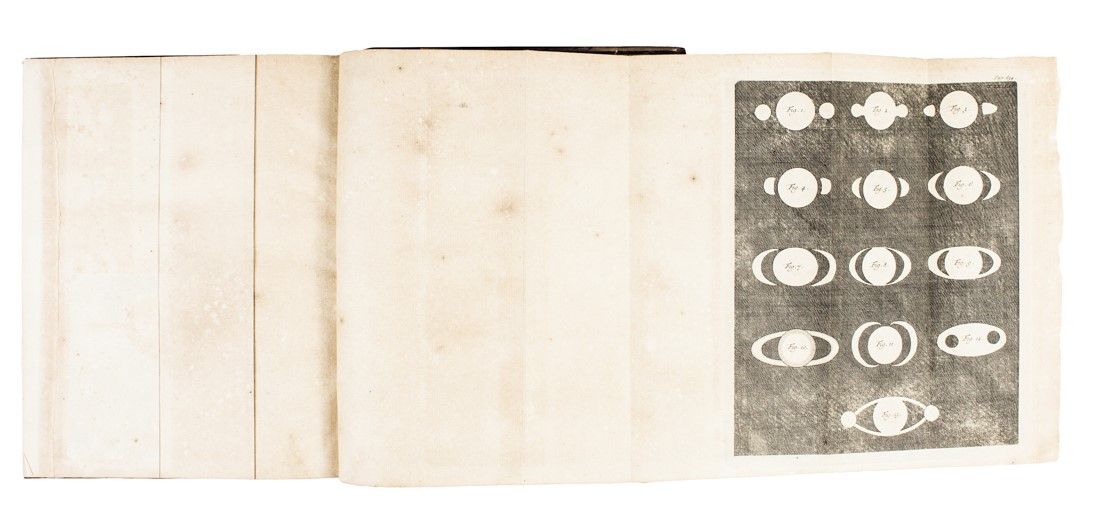HUYGENS, Christiaan (1629-1695). Horologium oscillatorium sive de motu pendulorum ad horologia aptato demonstrationes geometricae. Paris: F. Muguet, 1673. Presentation copy of the first edition of Huygen's most important work , containing the first mathematical analysis of the motion of the pendulum, and a general treatise on the dynamics of bodies in motion. The treatise ‘was the most original work of this kind since Galileo's Discorsi.... It ends with 13 theorems (without proofs) on the dynamics of circular motion. Newton in the Principia acknowledges Huygens's priority here, though Huygens's work had little influence on his own’ (PMM). ‘A work of the highest genius which has influenced every science through its mastery of the principles of dynamics. It is second in scientific importance perhaps only to the Principia ’ (C. Singer, A Short History of Science … , 1941, p. 258). Huygens constructed the first pendulum clock in 1657, an idea already put forth by Galileo, who had noted the isochronism of the pendulum (its property of swinging in a constant time, regardless of the width of the swing). The idea was a brilliant solution to the problems of keeping time aboard ship, since a reliable time-keeping device was essential for determining longitude, a problem of acute importance in 17th-century Holland, and Huygens' invention, described in the Horologium , was hugely successful – by 1658 pendulums were even applied to the tower clocks of Scheveningen and Utrecht. In the Horologium Huygens broadened his mathematical analysis of the pendulum's movement from a central exposition of the isochronism of the cycloid (a discovery which he had called ‘the most fortunate finding which ever befell me’ [DSB]) to a general mathematical discussion of the laws of motion. He focused on the properties of curves, including the theory of the evolutes of curves and the fall of bodies along curves, and determined the first exact value of the intensity of the force of gravity by using a compound pendulum. Dibner, Heralds 145; Grolier/Horblit 53; Norman 1137; PMM 154. Folio (312 x 202mm). Woodcut arms of Louis XIV on title, full-page woodcut of the pendulum on A2v, approximately 100 woodcut diagrams in text (outer portion of titlepage restored probably with removal of a stamp or inscription, lower half of last leaf restored with removal of a stamp, repair to the top margin of front flyleaf, a couple of quires lightly foxed). Contemporary speckled calf, spine gilt in compartments (skillfully rebacked with the original spine laid down, corners repaired, extremities a little rubbed). Provenance: presentation to an unknown recipient (Donné par l’autheur) on front flyleaf – ‘H. Geyler’ (jurist, c.17th c., inscription on front paste-down) – ‘Francais’ (18th c., inscription on front paste-down) – ‘G. Scherz Math. Prof.’ (?19th c., inscription on front paste-down).
HUYGENS, Christiaan (1629-1695). Horologium oscillatorium sive de motu pendulorum ad horologia aptato demonstrationes geometricae. Paris: F. Muguet, 1673. Presentation copy of the first edition of Huygen's most important work , containing the first mathematical analysis of the motion of the pendulum, and a general treatise on the dynamics of bodies in motion. The treatise ‘was the most original work of this kind since Galileo's Discorsi.... It ends with 13 theorems (without proofs) on the dynamics of circular motion. Newton in the Principia acknowledges Huygens's priority here, though Huygens's work had little influence on his own’ (PMM). ‘A work of the highest genius which has influenced every science through its mastery of the principles of dynamics. It is second in scientific importance perhaps only to the Principia ’ (C. Singer, A Short History of Science … , 1941, p. 258). Huygens constructed the first pendulum clock in 1657, an idea already put forth by Galileo, who had noted the isochronism of the pendulum (its property of swinging in a constant time, regardless of the width of the swing). The idea was a brilliant solution to the problems of keeping time aboard ship, since a reliable time-keeping device was essential for determining longitude, a problem of acute importance in 17th-century Holland, and Huygens' invention, described in the Horologium , was hugely successful – by 1658 pendulums were even applied to the tower clocks of Scheveningen and Utrecht. In the Horologium Huygens broadened his mathematical analysis of the pendulum's movement from a central exposition of the isochronism of the cycloid (a discovery which he had called ‘the most fortunate finding which ever befell me’ [DSB]) to a general mathematical discussion of the laws of motion. He focused on the properties of curves, including the theory of the evolutes of curves and the fall of bodies along curves, and determined the first exact value of the intensity of the force of gravity by using a compound pendulum. Dibner, Heralds 145; Grolier/Horblit 53; Norman 1137; PMM 154. Folio (312 x 202mm). Woodcut arms of Louis XIV on title, full-page woodcut of the pendulum on A2v, approximately 100 woodcut diagrams in text (outer portion of titlepage restored probably with removal of a stamp or inscription, lower half of last leaf restored with removal of a stamp, repair to the top margin of front flyleaf, a couple of quires lightly foxed). Contemporary speckled calf, spine gilt in compartments (skillfully rebacked with the original spine laid down, corners repaired, extremities a little rubbed). Provenance: presentation to an unknown recipient (Donné par l’autheur) on front flyleaf – ‘H. Geyler’ (jurist, c.17th c., inscription on front paste-down) – ‘Francais’ (18th c., inscription on front paste-down) – ‘G. Scherz Math. Prof.’ (?19th c., inscription on front paste-down).


.jpg)


.jpg)


.jpg)




Testen Sie LotSearch und seine Premium-Features 7 Tage - ohne Kosten!
Lassen Sie sich automatisch über neue Objekte in kommenden Auktionen benachrichtigen.
Suchauftrag anlegen